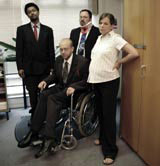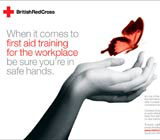Stock option
Using stock photography presents designers with a myriad of creative and legal challenges, including copyright issues, lack of originality and how to make them your own. Gareth Gardner suggests a path through the maze.

Using stock photography presents designers with a myriad of creative and legal challenges, including copyright issues, lack of originality and how to make them your own. Gareth Gardner suggests a path through the maze
Do you ever get that sinking feeling when sourcing images for a project? Especially when there is no budget for a shoot and it’s time to trawl the photograph libraries.
It’s often a cause for despair and for two main reasons. One is creative – how can you create something original from hackneyed stock photographs? The other is the grey area of copyright and how much you can manipulate images. While many designers simply hope for the best, there are legal risks involved.
Of the two main ways of sourcing images from libraries, rights-managed is preferred by most designers, as the images are more interesting. Usage terms are complex and images are licensed exclusively – which means they won’t be used by your client’s rivals – but can prove to be very expensive. Alternatively, there is royalty-free, where a flat fee is paid to use an image – generally a cheap way of obtaining photography. Yet using such generic images to reflect a client’s brand can be a challenge.
Photograph libraries tend to illicit a disappointed grumble from many designers, partly, perhaps, because of the domination of Getty Images – although it does provide massive choice, with more than 800 000 images in its ‘creative’ library.
It is royalty-free deals, in particular, that are inclined to make designers groan. ‘We tend to stumble across the same images so often,’ says Angus Mackinnon, creative director at design consultancy Nowwashyourhands. ‘So much is really hackneyed and done to death. It’s cheesy.’ His response is a spoof photograph library, with hilariously deadpan pictures demonstrating such themes as team building and equal opportunities. It is intended to be a reality check for the stock image industry.
Faced with small budgets – and the often incorrect client perception that stock imagery is cheaper than original commissions – designers will do their best with library images. ‘The challenge is making them your own,’ says Paul Burgess, group creative director at Loewy. The solution, he claims, is to manipulate them. ‘You mess them around,’ he says. ‘You might put cross-hairs over faces, change the colours or flatten the background. You make it relevant to the campaign.’ For recent graphics for the Red Cross, he used stock images with a red highlight colour pasted on to white backgrounds, to create individuality and give a cohesive identity to otherwise disparate images.
Like other designers, SAS Design creative director Gilmar Wendt makes ample use of stock photography for pitches and design concepts, but claims that trawling libraries for final design images can be very time-consuming. ‘We always prefer to use a photographer,’ he says, although, in some cases, stock imagery is the only option. For example, when depicting a particular event, such as the last Olympics, ‘it’s sometimes hard to emulate a really good shot, rather than use the original from the library’.
However, Wendt did use royalty-free images in the annual report for aerospace and defence systems specialist Meggitt. ‘We wanted to give [the company] a personality and to have ownership of a particular photographic style,’ he says. The solution was a mix of photography and graphics. ‘We treated the royalty-free images as raw material – they are barely recognisable,’ he says.
Due to budget constraints, royalty-free images were used in the refit of McDonald’s headquarters in East Finchley, by Claremont Group Interiors. ‘It meant we had to be more creative with the application of imagery on glazing, screening and furniture products,’ says design consultant Lesley McPhee. The neutral interior is accented by giant photographs sourced from Liquid Library.
Indeed, using large-scale images in interiors may be enough to ‘brand’ the image for a client. For the new Itsu sushi café on London’s Piccadilly, designer Afroditi Krassa sourced photographs of cherry blossom from Getty Images and printed them on to pink gels. ‘The images look very different now, but it is still partly the photographer’s work. You cannot just ignore that,’ says Krassa.

Vigilance is certainly in order when using library images. Nicola McCormick, associate at specialist law firm Michael Simkins LLP, advises against using library images that aren’t royalty-free, as they present formidable legal risks.
‘What you can and can’t do is specified in some detail. Libraries give you as limited rights as possible,’ she points out. Terms might specify that an image can only be reproduced exactly as it is, without manipulation. And don’t even think of using even a small piece of an image without permission, as it may be possible to argue that a qualitatively ‘substantial’ part has been used.
In the UK, photographers have moral rights, which means that if an image is manipulated in a derogatory fashion, legal action could result – and parody is not a legal defence. ‘Cases do come up,’ warns McCormick.
Reshooting an image that a client likes, from a library, to obtain an exact look or simply to have more control over usage, is also risky. ‘If every element is set up in the same way, you are effectively reproducing the original and will infringe the copyright,’ she says. And, if you create what you consider is a totally new piece of work, using manipulated stock photography, you may have copyright for the overall image, but the original photographer also retains copyright and may take action over infringement.
Royalty-free is generally safer ground. Designers generally have carte blanche ‘to use whatever they want, manipulate images or even cut chunks out’, says McCormick. Yet she recommends always combing the terms and conditions. ‘Check there are enough rights to do what you want to do,’ she says. She adds that you can’t always trust a library to have sorted out the legal small points with the photographer. ‘Ask around to find a reliable library. Lots have popped up on the Internet and you don’t know how well run they may be,’ she adds.
If anything, use of library images will grow, especially now that Adobe’s Creative Suite 2 provides access to royalty-free images, as well as connection to photograph libraries. It will make it easier than ever to use stock photographs, but do so at your own risk.
-
Post a comment



